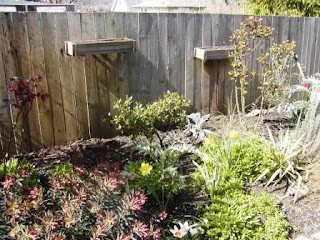I filled out each garden catalog form extensively and realized that my eyes were bigger than my garden. I needed to narrow down my choices. I went through my seed catalogs one by one to whittle down my lists. But, all those wonderful pictures of red-ripe tomatoes and perfect eggplant made it way too difficult to choose. And don't even get me started on the flowers!
I remembered an article my husband, Eldon, pointed out to me on Slate.com last year. Constance Casey gave free advice to the home gardener in
"What to look for in gardening catalogs." After which, Eldon sent away for the catalog she said was her favorite:
Kitchen Garden Seeds. Yay another one. Little did he know I had already ordered seeds for myself and friends by then, but I digress.
You'll get a glimpse of what I'm talking about just by looking at the cover of Burpee's catalog at the beginning of the article. Armfuls of tomatoes the size of grapefuits--very tempting! Constance says to go through the catalogs, fill out that order form and then tear it up.
I more or less did this. I put aside the order forms, and wrote down what I wanted to grow on a blank piece of paper.
I keep in mind these criteria as I make my wish list:
1. Can I find this in the market pretty easily and for a good price?
2. Is it aesthetically interesting?
3. Is it easy to grow?
4. How many days until harvest?
The ultimate, automatic criteria is whether Eldon requested it. Either that or he'll convert the garden into an apple orchard.
I then chose three seed companies I would go with.
Kitchen Garden Seeds easily made the cut since I didn't get a chance to order from them last year. The other two were
Baker Creek Heirloom Seeds and
Cook's Garden because their seeds were good performers last year.
From Kitchen Garden Seeds I ordered Swiss Chard 'Bright Lights,' Fennel 'Fino,' Kale 'Tuscano Lacinato,' and Fava Beans 'Supersette.' Swiss Chard Bright Lights, meets all the criteria. It's pretty, easy to grow, and takes around 60 days to mature. Eldon requests this for his dried fig and squab dish he makes at Thanksgiving.
Some of you may cringe at my choice with fennel. Yes, it can be a weed, but I am hoping I can harvest the flowers for different dishes. If I harvest the flowers, it will never go to seed and I'll prevent a fennel forest from forming along my street. I also like the feathery look of fennel. I am growing it mostly for the bulb. I saw one at the store this week for $3.99. Granted it was organic, but c'mon!
'Tuscano Lacinato,' also known as Dinosaur Kale, is wonderfully sweet and nutty; not at all bitter. The dark green leaves have an rippled texture and striking light green veins. It will be a great alternative when we get burnt out on the Swiss Chard. Another crop that will take 60 days to harvest.
I know. I know. Fava beans take about 100 days to mature so I may not produce a crop. But, when they're $3.99/lb at the market, I'll pay $3.50 for 50 seeds and take my chances. The description boasts white and purple flowers yielding 7-9 beans per pod. Plus, how can you argue with when the cultivar is 'Supersette'!?

Stay tuned for when I review my orders for Baker Creek Heirloom Seed and Cook's Garden.



























